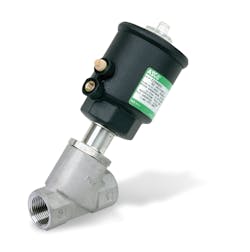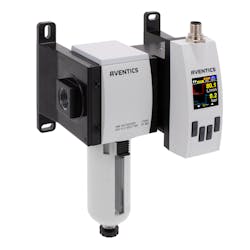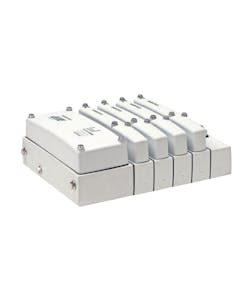Enhancing sustainability, safety and maintenance using smart pneumatics

Pneumatics has always been a go-to technology in food and beverage processing applications — and for good reason. Pneumatics technology is clean, reliable, safe and easy to maintain. Even more, its design features can improve performance and lower costs.
And now, with the digital transformation taking place in the food and beverage industry, pneumatics is an even better choice. By integrating connected pneumatic devices, processing equipment can be safer to operate and predictive maintenance can be enhanced. Plus, energy use can be monitored and closely controlled.
IIoT connectivity
Pneumatics equipment can now be equipped with sensors that measure key operating parameters such as temperature, pressure, flow rates, cycle times, valve response rates and more. Using this information, companies can monitor machine performance more clearly than ever before.
Original equipment manufacturers (OEMs) can now include pneumatic monitoring capabilities that detect a pneumatic system’s operating state, analyze the data and forward alerts to the right people in a plant. In doing so, they can provide reliable information on the condition of actuators, valves and other devices.
These new capabilities are being enabled as part of the Industrial Internet of Things (IIoT) functionality.
Energy use
There is a greater push to decarbonize industries than ever before, and more customers are demanding environmentally responsible products. As a result, sustainability is becoming a core priority for many businesses, and integrating smart pneumatics is one way food and beverage processing plants can save energy and better achieve sustainability goals.
The compressed air used in applications throughout food and beverage plants is often responsible for a significant amount of a facility’s energy consumption. Even tiny fluid leaks, if left unattended, can cause huge energy losses in mechanical systems. Without a reliable way to evaluate compressed air consumption, it’s often difficult to pinpoint the cause or the source of the problem.
Pneumatic sensors, such as the AVENTICS Series AF2 flow sensor from Emerson, continuously monitor the pressure and flow of these systems in real time, offering a more complete picture of pneumatic system performance. The data and insights these sensors provide enable plant operators to better understand and effectively control compressed air consumption and address potential problems before they occur.
Facilities can save in compressed air energy costs and reduce their carbon footprint through early leak detection. Examples where this can be valuable is for the actuation of critical components such as automated hygienic valves, which are used throughout a facility moving vital process/consumable media. Alarms or alerts can be sent to the appropriate managers if a leak is detected.
Enhanced maintenance
Because wear and tear are expected in any industrial setting, maintenance is where IIoT capabilities can become extremely helpful. Plant operators can implement a new level of predictive maintenance using IIoT-enhanced pneumatics. By comparing a machine’s performance to established set points, an IIoT edge device can notify the appropriate manager if the system is not meeting the established standards.
For instance, maintenance technicians could determine that a shock absorber on the end of an actuator is deteriorating just by sensing an increase in cycle speed, even by a few milliseconds. Or, machine builders could take advantage of the diagnostic features of IIoT-enhanced pneumatics to measure critical parameters like cylinder velocity.
In either case, knowing which equipment requires maintenance allows plant engineers to avoid unplanned downtime by replacing components with shorter and fewer planned machine stops.
A safer workplace
Pneumatics technology is already highly regarded for its contribution to worker safety, incorporating several safety features and components that protect operators and equipment, prevent downtime, improve reliability and extend operational life. The IIoT enhances pneumatics technology even further, providing new tracking and measurement capabilities. These new features give operators even greater insight into the performance of a machine and its components and subsystems.
A good example would be a machine with a safety light curtain controlling a valve. If the valve response time changed from 30 milliseconds to 50 milliseconds, or even 70 milliseconds, an operator would be able to get much further into the dangerous motion area of a machine before a safety response event could be triggered. Normally, that kind of situation would not have been noticed or addressed before the device reached its mission time replacement cycle. However, with IIoT capability, that decline in the valve response time (and the corresponding alert response time) would be captured, analyzed and reported in time for corrective action — before any deterioration in functionality that would put the machine operator at risk.
In addition, Emerson’s integrated, scalable, zoned safety approach requires fewer connections and saves valuable real estate within the machine and manifold, reducing the number of safety system components. This approach helps design engineers satisfy regulations by allowing up to three safety zones to be isolated on a machine from a single pneumatics assembly. A valve manifold can be configured to shut down pilot air and power only to the equipment that will come in contact with the operator, leaving the rest of the machine in operation.
Other advantages of pneumatics
Beyond digital transformation, pneumatics technology offers a wide range of other benefits for food and beverage processors, including:
Cleanliness. Pneumatics equipment is ideal for work where frequent washdowns are required. There are even pneumatic valves for sanitary conditions, withstanding aggressive detergents and chemicals.
Reliability. Pneumatics equipment is less complex than other power technologies and, as a result, is known for dependable operation with less downtime. Pneumatic valves, such as the ASCO Series 8290, are engineered for high actuation rates and can handle high-speed production or high-speed motion sequences for packaging or for safe, rapid and reliable control of process valves and auxiliary valves for processing.
In addition, the latest angle body valves are designed to provide reliability and high performance in demanding food and beverage environments, such as clean-in-place (CIP) and steam-in-place (SIP) systems that deliver cleaning solutions and rinse water or steam through process equipment. Rated for high-temperature fluids and steam up to 356° F, these valves are designed with heavy-duty polytetrafluoroethylene (PTFE) seals for reliable shut-off performance and stainless steel valve bodies and actuators for corrosion resistance and extended life.
Flexibility. Some angle body valves are modular, with a wide range of designs, end connections, interchangeable actuators and switch boxes. This level of flexibility makes it possible to use one valve for a variety of media.
Cost. On a component-by-component comparison, pneumatic devices generally have a lower initial cost than electronics. And in operation, pneumatic technology is extremely cost-effective, becoming most efficient when the total demand nears the capacity of the compressor. Plus, there is little added cost to add more devices, since compressed air is already being used throughout most food and beverage plants.
Training. As food and beverage processors deploy pneumatics throughout their plants, they are finding their teams need less ramp-up and training time with the introduction of new equipment.
Pneumatics technology: A good fit for food & beverage
Always a strong contender for any food and beverage processing application, the digital transformation of pneumatics technology has enhanced its capabilities for preventive maintenance, worker safety and energy savings. Best of all, it is not only scalable, it actually becomes more efficient as plant operators add more equipment — not simply as the total demand for pneumatics nears the capacity of the air compressors, but as plant workers become more familiar and comfortable with the technology.
Eileen Voges is a product marketing manager at Emerson. In her role, she is responsible for a number of markets, including food and beverage. Prior to this role, she served as a strategic planner for acquisition integration and a marketing analytics manager for Emerson in Hannover, Germany. She received a Bachelor of Science in Chemical Engineering from Columbia University.
About the Author
Eileen Voges
Product Marketing Manager, Emerson Fluid & Motion Control
Eileen Voges is a product marketing manager at Emerson. In her role, she is responsible for a number of markets, including food and beverage. Prior to this role, she served as a strategic planner for acquisition integration and a marketing analytics manager for Emerson in Hannover, Germany. She received a Bachelor of Science in Chemical Engineering from Columbia University.

